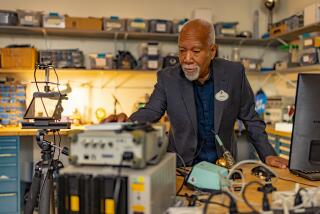New Dimension to 3-D : Television Producer Turns His Attention to Multimedia Technology
- Share via
Television producer Max Keller, with his bright orange blazers and indescribably garish ties, seems an improbable choice to champion a technological innovation--much less sip tea with PhDs at Cambridge University or rub shoulders with button-down executives at defense electronics concern Litton Industries.
Low-budget syndicated TV fare--Keller’s big successes so far include “Acapulco H.E.A.T.” and “Tarzan”--seems much more his style.
But about two years ago, Keller decided he wanted to break into multimedia. After reading a magazine article about a new technology for creating three-dimensional display images invented by Cambridge electro-optical specialist Adrian Travis, he hopped a plane for England.
Leaving his usual ensemble in his suitcase, Keller donned a dark suit and met with Travis and fellow Cambridge scientist Stewart Lang, and an unlikely alliance was born.
Keller’s start-up Sherman Oaks firm, Infinity Multimedia, aims to use the British scientists’ technology to develop 3-D displays for everything from video games to fighter planes to computer modeling. And the big payoff could come if the 3-D gear is eventually used in consumer electronics products, including televisions and personal computers.
While Infinity’s efforts are a long way from fruition, Litton has lent its support, agreeing to do the several million dollars’ worth of research and development work needed to produce a prototype. In exchange, Litton will market the 3-D technology for defense and aerospace applications and license its display design to other companies.
Travis, described by those who know him as a brilliant young scientist who is having a good day when he wears matching socks, initially developed the 3-D technology in 1993 while researching ways to control the direction of light. Together with Lang, a PhD in computer graphics, he formed Autostereo Systems Ltd. to commercialize the 3-D process. But they lacked the marketing know-how and agreed to license the technology to Infinity.
Their technique for producing 3-D images, known as the autostereoscopic method, is most notable for what it lacks: No glasses or other cumbersome headgear is required. And it gives viewers the ability to “see” a scene from different angles, a highly desired feature missing from many competing technologies under development.
The quest for realistic 3-D images is nothing new, and the basic concept is relatively simple: To see in 3-D, each eye must view an image from a slightly different perspective. The two images are fused in the brain, producing the appearance of depth. That’s the principle behind the old stereoscopes and, later, View-Masters. The 3-D movies that were popular in the 1950s required viewers to wear glasses that served as filters, ensuring that each eye saw a different image.
The Infinity technique creates 3-D images without glasses through a complex process that’s only now possible because of today’s super-fast computers. It involves flashing compressed versions of multiple views of the same scene on a screen very quickly, and uses a new method of seamlessly “blending” the images. The resulting display also allows the viewer to move his or her head from side to side and see different perspectives of the image, without losing the 3-D effect or seeing a blurry picture.
Infinity’s efforts to bring the process to market are being led by its vice president of technology, Peter Canepa, a former Litton executive. The first prototype is due to be completed in September. Until then, Infinity is using off-the-shelf computer components that have been put together to demonstrate the technology.
The response so far has been favorable.
“I think it’s one of the most promising technologies,” said Giuseppe Delena, a chief designer at Ford Motor Co.
Delena envisions using computers incorporating the 3-D method for designing cars. He’s particularly impressed with the “look-around” feature of the Infinity technique that’s missing from other 3-D displays he has seen.
Thomson, the French consumer electronics concern that makes RCA television sets, plans eventually to develop a TV monitor using the Infinity technology.
Even so, the future for 3-D displays appears fuzzy. Even the most advanced technology could be decades away from tuning into big commercial markets. The cost is likely to be steep, and applications will probably be limited for some time to high-end users such as the government or big corporations.
Keller wants to break into the arcade business initially--a logical first step, observers say. But he hopes that will provide a toehold in consumer markets later on, and that’s a much iffier proposition.
“It would be a long time before something like this would be applicable to broadcast TV,” said Jeff Mazur, director of graphic systems for ABC-TV’s on-air promotions.
Mazur wants ABC to experiment in 3-D but said the Infinity technology would be impractical because it would require huge investments in new equipment capable of filming and transmitting broadcast signals in 3-D.
“Then there’s the whole issue of whether people want 3-D TV in their homes,” Mazur added. “Are you going to require everyone to throw out their TV sets and buy new ones? The earliest I could see something like that happening is 20 to 30 years down the road.”
Nonetheless, Keller is convinced he’s on to something big. Bruce Whitehead, vice president for strategic development at Litton’s navigation, guidance and control systems group in Woodland Hills, said he was skeptical when he first heard about the Infinity technology. He assumed it would be similar to the renderings of 3-D images on 2-D computer and video displays that are already commonplace. Instead, he was “quite surprised and intrigued” to find “it’s really 3-D.”
Now Litton is hoping to find applications for the technology in air traffic control systems, satellite data displays, tactical battle control systems and military training simulators.
Patrice Apodaca can be reached via e-mail at patrice.apodaca@latimes.com







